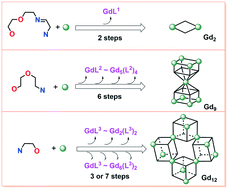当前位置:
X-MOL 学术
›
CrystEngComm
›
论文详情
Our official English website, www.x-mol.net, welcomes your feedback! (Note: you will need to create a separate account there.)
Manipulating clusters by regulating N,O chelating ligands: structures and multistep assembly mechanisms
CrystEngComm ( IF 3.1 ) Pub Date : 2020/01/02 , DOI: 10.1039/c9ce01730e Hai-Ling Wang 1, 2, 3, 4 , Zi-Yuan Liu 1, 2, 3, 4 , Zhong-Hong Zhu 1, 2, 3, 4 , Jin-Mei Peng 1, 2, 3, 4 , Xiong-Feng Ma 1, 2, 3, 4 , Juan Bai 1, 2, 3, 4 , Hua-Hong Zou 1, 2, 3, 4 , Kai-Qiang Mo 1, 2, 3, 4 , Fu-Pei Liang 1, 2, 3, 4, 5
CrystEngComm ( IF 3.1 ) Pub Date : 2020/01/02 , DOI: 10.1039/c9ce01730e Hai-Ling Wang 1, 2, 3, 4 , Zi-Yuan Liu 1, 2, 3, 4 , Zhong-Hong Zhu 1, 2, 3, 4 , Jin-Mei Peng 1, 2, 3, 4 , Xiong-Feng Ma 1, 2, 3, 4 , Juan Bai 1, 2, 3, 4 , Hua-Hong Zou 1, 2, 3, 4 , Kai-Qiang Mo 1, 2, 3, 4 , Fu-Pei Liang 1, 2, 3, 4, 5
Affiliation

|
We obtained a binuclear Gd(III) complex [Gd2(L1)2(NO3)4] (1, HL1 = (E)-2-(2-(pyridin-2-ylmethyleneamino)ethoxy)ethanol) by reacting N2O2-tetradentate chelating ligand HL1 with Gd(NO3)3·6H2O at solvothermal temperature of 100 °C. Time-dependent high-resolution electrospray ionization mass spectrometry (HRESI-MS) followed the formation of 1 and revealed it's the assembly mechanism: HL1 → Gd(L1) → Gd2(L1)2. When we used the NO2-tridentate chelating ligand HL2 (HL2 = 2-(2-aminoethoxy)ethanol) under the same reaction conditions, we obtained an “hourglass-like” nonanuclear Gd(III) cluster [Gd9(L2)8(μ3-OH)8(μ4-O)2(NO3)8]·2CH3OH·H2O (2). Their assembly mechanism was proposed: HL2 → Gd(L2) → Gd2(L2)2 → Gd3(L2)3 → Gd4(L2)4 → Gd5(L2)4 → Gd9(L2)8. Most notably, when we used the NO-bidentate chelate ligand HL3 (HL3 = picolinic acid), we obtained a dodecanuclear Gd(III) cluster [Gd12(L3)8(OH)16(NO3)8(OH)4(H2O)4]·22CH3OH·25CH3CN (3) under the same reaction conditions. We found that the formation process of cluster 3 involved two different and mutually interfering self-assembly processes, namely, multitemplate-induced assembly (HL3 → Gd(L3) → Gd2(L3)2 → Gd12(L3)8) and stepwise assembly (HL3 → Gd(L3) → Gd2(L3)2 → Gd3(L3)2 → Gd4(L3)2 → Gd5(L3)2 → Gd6(L3)2 → Gd12(L3)8).
中文翻译:

通过调节N,O螯合配体来操纵团簇:结构和多步组装机制
我们获得了双核Gd(III)络合物[Gd 2(L 1)2(NO 3)4 ](1,H L 1 =(E)-2-(2-(吡啶-2-基亚甲基氨基)乙氧基)乙醇)使N 2 O 2-四齿螯合配体H L 1与Gd(NO 3)3 ·6H 2 O在溶剂热温度为100°C下反应。随时间变化的高分辨率电喷雾电离质谱(HRESI-MS)随即形成1,并揭示了其组装机理:HL 1 →Gd(L 1)→Gd 2(L 1)2。当我们在相同的反应条件下使用NO 2-三齿螯合配体H L 2(H L 2 = 2-(2-氨基乙氧基)乙醇)时,我们获得了一个“沙漏状”的非核Gd(III)簇[Gd 9(大号2)8(μ 3 -OH)8(μ 4 -O)2(NO 3)8 ]·2CH 3 OH·H 2 O(2)。提出了它们的组装机理:H L 2 →Gd(L 2)→Gd 2(L 2)2 →Gd 3(L 2)3 →Gd 4(L 2)4 →Gd 5(L 2)4 →Gd 9(L 2)8。最值得注意的是,当我们使用NO-双齿螯合配体H L 3(H L 3=吡啶甲酸),我们获得了十二烷Gd(III)簇[Gd 12(L 3)8(OH)16(NO 3)8(OH)4(H 2 O)4 ]·22CH 3 OH·25CH 3 CN (3)在相同反应条件下。我们发现,簇3的形成过程涉及两个不同且相互干扰的自组装过程,即多模板诱导的组装(H L 3 →Gd(L 3)→Gd 2(L 3)2 →Gd 12(L 3)8)和逐步组装(H L 3 →Gd(L 3)→Gd 2(L 3)2 →Gd 3(L 3)2 →Gd 4(L 3)2 →Gd 5(L 3)2 →Gd 6(L 3)2 →Gd 12(L 3)8)。
更新日期:2020-02-13
中文翻译:

通过调节N,O螯合配体来操纵团簇:结构和多步组装机制
我们获得了双核Gd(III)络合物[Gd 2(L 1)2(NO 3)4 ](1,H L 1 =(E)-2-(2-(吡啶-2-基亚甲基氨基)乙氧基)乙醇)使N 2 O 2-四齿螯合配体H L 1与Gd(NO 3)3 ·6H 2 O在溶剂热温度为100°C下反应。随时间变化的高分辨率电喷雾电离质谱(HRESI-MS)随即形成1,并揭示了其组装机理:HL 1 →Gd(L 1)→Gd 2(L 1)2。当我们在相同的反应条件下使用NO 2-三齿螯合配体H L 2(H L 2 = 2-(2-氨基乙氧基)乙醇)时,我们获得了一个“沙漏状”的非核Gd(III)簇[Gd 9(大号2)8(μ 3 -OH)8(μ 4 -O)2(NO 3)8 ]·2CH 3 OH·H 2 O(2)。提出了它们的组装机理:H L 2 →Gd(L 2)→Gd 2(L 2)2 →Gd 3(L 2)3 →Gd 4(L 2)4 →Gd 5(L 2)4 →Gd 9(L 2)8。最值得注意的是,当我们使用NO-双齿螯合配体H L 3(H L 3=吡啶甲酸),我们获得了十二烷Gd(III)簇[Gd 12(L 3)8(OH)16(NO 3)8(OH)4(H 2 O)4 ]·22CH 3 OH·25CH 3 CN (3)在相同反应条件下。我们发现,簇3的形成过程涉及两个不同且相互干扰的自组装过程,即多模板诱导的组装(H L 3 →Gd(L 3)→Gd 2(L 3)2 →Gd 12(L 3)8)和逐步组装(H L 3 →Gd(L 3)→Gd 2(L 3)2 →Gd 3(L 3)2 →Gd 4(L 3)2 →Gd 5(L 3)2 →Gd 6(L 3)2 →Gd 12(L 3)8)。


























 京公网安备 11010802027423号
京公网安备 11010802027423号